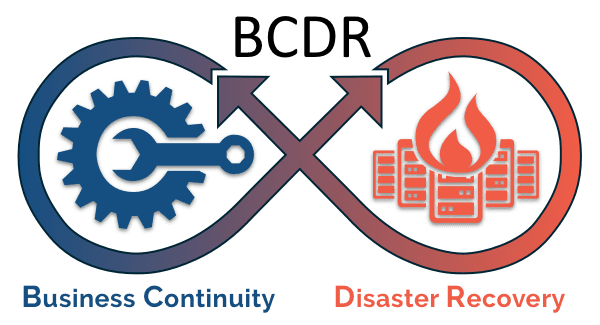Companies need to be prepared for catastrophic events such as power outages, cyber attacks, or natural disasters, leading to a startling 25 percent closure rate for small businesses that experience a total shutdown, as reported by the US Federal Emergency Management Agency. A Business Continuity and Disaster Recovery (BCDR) strategy ensures this preparedness.
Business Continuity and Disaster Recovery (BCDR) is a set of practices that seamlessly integrates people, technology, and processes. The objective is to enable organizations to either sustain or recover their business operations (and data) following a disaster. The framework itself should have a minimal impact on the business performance. But, achieving this requires the development, deployment, and regular testing of a comprehensive Business Continuity Plan.
A Business Continuity Plan is a framework of precise steps to ensure the seamless continuation of business operations in the event of a disaster or the inaccessibility of the workplace. Striking the delicate balance between comprehensive detail and adaptability to various scenarios is crucial for the plan's effectiveness. Common threats addressed include human error, malicious sabotage, cyber attacks, hardware failure, and power cuts or natural disasters.
Beyond securing critical business functions, identifying and safeguarding specific assets crucial to the business is paramount. This includes servers, phones, network connections, network drives, online systems, and business-related applications. Implementing a business continuity plan serves as a safeguard, ensuring operational continuity and data protection even amidst unforeseen challenges.
Validating the efficacy of a business continuity plan is closely related to "Disaster Recovery." While business continuity centers on maintaining all aspects of business during disruptions, disaster recovery focuses on the IT and technology systems supporting these functions. Business continuity's primary aim is to sustain critical functions during disruptions, while disaster recovery concentrates on the restoration of normal operations post-disruption, with a specific focus on IT systems. Both efforts utilize the same plans, personnel, and procedures. Metrics such as Recovery Time Objective (RTO) and Recovery Point Objective (RPO) serve as common benchmarks to gauge success.
Both business continuity and disaster recovery efforts are not tethered to the specific cause of a disruptive event. Whether the disruption stems from human error, cyber attacks, or natural disasters, the overarching goal remains consistent: ensuring the continuity and recovery of business operations.
In all security endeavors, the highest priority should be the health and safety of individuals. This principle is especially pronounced in business continuity and disaster recovery efforts, with very few exceptions.
By meticulously crafting comprehensive plans, safeguarding critical assets, and prioritizing rigorous testing and recovery efforts, businesses can significantly enhance their resilience.
In summary, BCDR encompasses the practices and plans necessary for an organization to withstand, respond to, and recover from disruptions, ensuring the continuity of critical business functions and the protection of vital assets.
Key concepts
-
Business Continuity and Disaster Recovery (BCDR):
-
Business Continuity (BC):
The strategic and planning process designed to ensure an organization can respond with minimal disruption to business operations in the event of a disaster or disruption. It involves creating a framework to enable the continued functioning of critical business functions during adverse circumstances. -
Disaster Recovery (DR):
A subset of BCDR that specifically focuses on the recovery of IT or technology systems that support business functions. It involves the restoration of normal operations after a disruption, primarily concentrating on the recovery of IT infrastructure.
-
Business Continuity (BC):
-
Business Continuity Plan:
- A detailed and systematic business process that outlines steps to ensure an organization can continue operating in the event of a disaster or if a workplace becomes inaccessible. It encompasses strategies for maintaining critical functions and operations during disruptions while providing adaptability for various scenarios.
-
Common Causes of Business Downtime:
-
Human Error:
Mistakes or errors made by individuals within an organization that can lead to disruptions in business operations. -
Malicious Sabotage:
Deliberate acts intended to harm or disrupt business operations, often carried out by internal or external entities. -
Cyber Attacks:
Malicious activities targeting computer systems, networks, or infrastructure to compromise confidentiality, integrity, or availability of data and services. - Hardware Failure:
The breakdown or malfunction of physical devices, such as servers or networking equipment, leading to disruptions in business operations. - Power Cuts / Natural Disasters:
Unplanned power outages or catastrophic events like earthquakes, floods, or fires that can cause widespread disruptions to business operations.
-
Human Error:
- Critical Business Assets:
- Specific components and systems within an organization that are essential for its operations. These may include servers, phones, network connections, network drives, online systems, and business-related applications.
-
Recovery Time Objective (RTO) and Recovery Point Objective (RPO):
- Recovery Time Objective (RTO):
The targeted duration within which a business process or system must be restored after a disruption to avoid significant consequences. - Recovery Point Objective (RPO):
The acceptable amount of data loss measured in time, indicating the maximum tolerable period between the last available backup and the occurrence of a disruption.
- Recovery Time Objective (RTO):
-
Health and Human Safety:
- The paramount consideration in security efforts, emphasizing the well-being and safety of individuals. This principle embodies the ethical and moral responsibility of organizations to prioritize human safety in all circumstances.
- Event Any occurrence that takes place during a certain period of time
- Incident An event that has a negative outcome affecting the confidentiality, integrity, or availability of an organization's data
